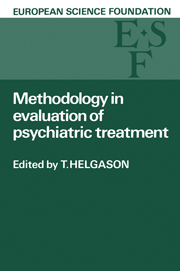 Methodology in Evaluation of Psychiatric Treatment
Methodology in Evaluation of Psychiatric Treatment from IV - OTHER QUANTITATIVE METHODS OFEVALUATION OF TREATMENT
Introduction
Darrow (1964) defined psychophysiology as “the science which concerns those physiological activities which underlie or relate to psychic functions”. This wide definition could be construed to refer to a very comprehensive range of central nervous system functions but in practice a particular experimental approach using certain physiological measures is accepted as that of psychophysiology. The position of psychophysiology has been an uneasy one, spanning the area between human physiology and psychology and yet developing concepts and principles which are peculiar to itself. Nevertheless, certain fundamental principles have to be upheld. Firstly, the functions that are recorded are basically physiological and, therefore, must be measured under strictly physiological conditions. For example, cardiovascular variables must be recorded under carefully controlled conditions. Secondly, the measures have to be shown to have some psychological validity. The heart pumps blood round the body and its rate is primarily governed by this need. In times of stress an increase in heart-rate may occur but this may reflect increased bodily activity rather than psychological arousal. There is no easy solution to this problem of apportioning bodily changes into the physiological and psychophysiological. However, two measures have come over the years to be regarded as particularly useful because their physiological element is minor. These are skin conductance (sweat-gland activity) and the electroencephalogram (EEG) analysed mathematically.
Psychophysiological techniques have been used mainly to aid in the diagnosis of psychiatric patients, to elucidate central mechanisms of mental illness and to monitor response to treatment. Inthis presentation, the last application will be outlined with particular emphasis on the practical value of these complex techniques. Firstly, the relevant techniques will be briefly outlined.
Psychophysiological techniques
Peripheral autonomic
The most commonly used measure is the palmar skin conductance which provides an indirect measure of non-thermo-regulatory sweating on the palms of the hands. The responses to stimuli, an increase in conductance, are termed galvanic skin responses (GSR) or electrodermal responses. Useful information can be obtained from the changes in skin conductance level, the responses, and ‘spontaneous’ fluctuations in level. Skin potential is a related but more complex measure.
Several cardiovascular measures are in use of which heart-rate is the most popular. This can be recorded from the ECG or from a pulse detector. Variations in beat-to-beat interval rate are of interest. Blood flow through the forearm (muscle blood flow) or the finger (skin blood flow) can be measured plethysmographically.
To save this book to your Kindle, first ensure [email protected] is added to your Approved Personal Document E-mail List under your Personal Document Settings on the Manage Your Content and Devices page of your Amazon account. Then enter the ‘name’ part of your Kindle email address below. Find out more about saving to your Kindle.
Note you can select to save to either the @free.kindle.com or @kindle.com variations. ‘@free.kindle.com’ emails are free but can only be saved to your device when it is connected to wi-fi. ‘@kindle.com’ emails can be delivered even when you are not connected to wi-fi, but note that service fees apply.
Find out more about the Kindle Personal Document Service.
To save content items to your account, please confirm that you agree to abide by our usage policies. If this is the first time you use this feature, you will be asked to authorise Cambridge Core to connect with your account. Find out more about saving content to Dropbox.
To save content items to your account, please confirm that you agree to abide by our usage policies. If this is the first time you use this feature, you will be asked to authorise Cambridge Core to connect with your account. Find out more about saving content to Google Drive.